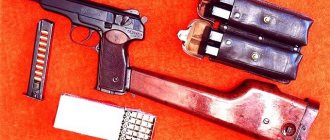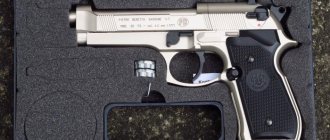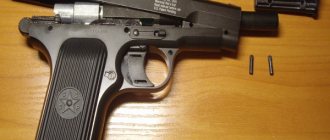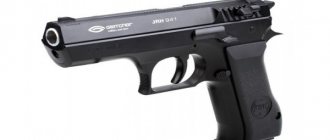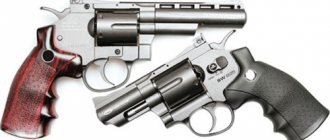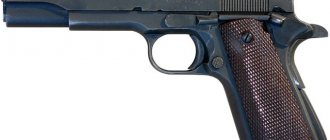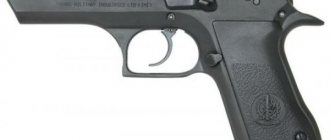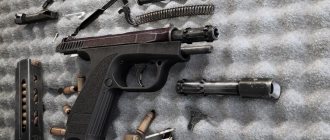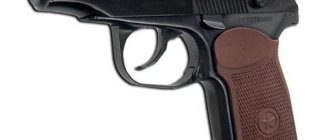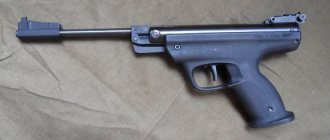For fans of historical Soviet weapons, the Gletcher company has been producing gletcher aps nbb and gletcher aps blowback for several years. The abbreviation APS in the spelling of the model stands for Stechkin automatic pistol. The prototype of the American weapon entered the USSR army in 1951 at the same time as the Makarov, but became unpopular with combat officers due to its inconvenient holster and dimensions. On the contrary, APS has gained recognition among special service soldiers and is still used to this day, along with a silent modification - ABP.
Operational and performance characteristics
The Gletcher APS pistol is a gas-cylinder pneumatic weapon. The energy source is a carbon dioxide cylinder.
Externally, Glacier APS is very similar to the original. The body and most parts of the model are made of light alloy, and the handle is finished with plastic. Among the noticeable differences from the original, it is worth noting the false barrel, which is clearly less than 9 mm.
Specifications
In addition, the pneumatic version of the APS does not fire in automatic mode: the safety lever looks the same as in the combat version of the APS, but switch it to the “automatic” mode. it is forbidden.
Read about the modernization of the IZH 53m air pistol at the link.
To simulate the recoil of military weapons in the Glacier APS, the Blowback system was used. The trigger, as in the original, is double-action. The muzzle velocity of the bullet exceeds 120 m/s, and one cylinder is enough to shoot about four magazines (there are 22 balls in one magazine).
The weapon pleases with good accuracy - when firing from five meters, the balls fall no further than 2 cm from each other.
The main tactical and technical characteristics of the pistol look like this:
| Caliber | 4.5 mm |
| USM | double acting |
| Length | 225 mm |
| Weight | 1.04 kg |
| Shop | 22 balls |
| Muzzle velocity | 120 m/s |
Review of the Gletcher APS NBB air pistol
The American manufacturer produces two modifications of the Stechkin - with and without a blowback system. The model described today does not have a blowback, as indicated by the letters “NBB” in the markings. Due to this, the consumption of carbon dioxide is quite small - the canister is enough for about 80 shots.
The Gletcher APS NBB air pistol has a double trigger, a long fixed barrel and a movable bolt, the stroke of which is significantly shorter than that of its firearm counterpart. You can shoot by self-cocking, as well as by cocking the hammer.
After the magazine is empty, the pistol automatically engages the slide stop. The manufacturer provides disassembly almost identical to the original.
Comparison of strengths and weaknesses
Strengths of the Gletcher APS NBB air pistol:
- Fixed barrel of solid length, increasing accuracy and accuracy.
- Good replica of the model, can be disassembled.
- Gas savings due to the absence of a blowback and the presence of a 3Z.
- Hidden screw for tightening the cylinder.
- The trigger has a steel insert that increases its strength.
- Good build quality.
Disadvantages of Stechkin:
- The store is too narrow.
- The price of the model is quite high.
- It is inconvenient to change the cylinder, especially in the field. To do this, you need to carry a hexagon with you.
- The bolt is fragile - it can break off at the edge, hitting the iron weight when cocking the hammer.
- Large dimensions and weight.
- Conspicuous white inscriptions of the manufacturer.
Photo of the Gletcher APS NBB air pistol
Where is it used?
The model is used for training, shooting practice, and for outdoor entertainment (it destroys bottles quite effectively). The pistol also performed well at hardball competitions - eighty shots from the can is enough for the entire game.
In addition, this very realistic replica may be of interest to collectors of pneumatic replicas of famous firearms.
Device and circuit
As already noted, the trigger in Glacier APS is double-action. The Blowback system well simulates the recoil of a military weapon - part of the compressed gas from the cylinder is spent on recoil of the bolt. After the magazine is fired, the shutter is automatically delayed - another similarity to the original. See photo:
Gletcher APS device
The magazine in this model is made separately from the cylinder, and is removed in the same way as in the original - by pressing a button on the handle.
The cylinder itself is installed under the lining on the handle. The cylinder is pierced by tightening the tightening screw.
The safety lever can be switched in two positions - single shot firing and safety. See also the material about the CZ 75 tactical sports pistol.
Disassembly and assembly of the air pistol Glatcher APS
Of course, many people say “if you don’t know, don’t interfere!” However, there are situations where you have to climb. I decided to familiarize newbies and G-APS owners a little with the difficulties of assembling this subject.
And so the first. It will take 3 minutes to analyze the case and I will not describe in detail how this is done. Remove the shutter and unscrew the screws.
MAIN !!!! Don't lose the details!!! When you separate the halves of the case, several important things may fly out.
1) Trigger return spring (not shown here)
2) Frame return spring.
3) Metal bracket (inserted into the trigger)
4) Trigger holder spring.
5) Magazine holder spring. PS I sowed it but it’s very easy to replace. use part of the spring from a regular ballpoint pen)))
Well, if you haven’t lost all the details, then let’s start collecting))
1) Start by installing the receiver
2) Install the frame by first inserting the trigger into it. Don't forget about the spring!!!
4) Installation of thrust s.k. Start by putting it on your s.k. at an angle of 90 degrees (1) and holding the bracket with your hand, put it in place. Make sure that the edge of the s.k. got into the place between two “antennae” (2).
1)
2)
5) Now install the return spring s.k. Just place it resting in the groove of the s.k. and the wall of the frame.
6) Dress the other half very carefully. It will be better if the half we were working on now lies on the table and in the meantime you put the second one on it.
7) When you do this you will have some distance between the halves of about 3-5 mm.
 Turn the gun (HOLDING BOTH HALVES!!!) with the barrel towards you, lower the frame and the end of the return spring will appear in front of you. Take a screwdriver, or better yet, a knife, press its tip against the spring, and in the meantime continue to connect both halves. If you hear a click, then your s.k. bracket has come off. with traction. You can check if this is so by holding the upper parts of the halves and with a little effort, work a little with the s.k. NOT COMPLETELY! Just move it 2-3mm and if you see that the end of the trigger rod moves, then everything is in order.
Turn the gun (HOLDING BOTH HALVES!!!) with the barrel towards you, lower the frame and the end of the return spring will appear in front of you. Take a screwdriver, or better yet, a knife, press its tip against the spring, and in the meantime continue to connect both halves. If you hear a click, then your s.k. bracket has come off. with traction. You can check if this is so by holding the upper parts of the halves and with a little effort, work a little with the s.k. NOT COMPLETELY! Just move it 2-3mm and if you see that the end of the trigger rod moves, then everything is in order.
 The hardest thing. You need to fasten the lower parts of the halves together by putting the frame return spring in place.
The hardest thing. You need to fasten the lower parts of the halves together by putting the frame return spring in place.
Since you have connected the parts you can only get to it through the hole for the magazine and a small crack between the sections.
A needle file or something thin, long and durable is suitable for this. Since this spring is small, but tight. I used a needle file with a tip diameter of 2 mm. Your task is simply to rest it against the spring and, in the meantime, compress both sections of the gun.
ATTENTION!!! If you hear a click, then your s.k. bracket has come off. with traction. You can check if this is so by holding the upper parts of the halves and with a little effort, work a little with the s.k. NOT COMPLETELY! Just move it 2-3mm and if you see that the end of the trigger rod moves, then everything is in order.
If you see that the sections of the gun are no longer held in place because of the spring, but because of your file, then without reducing the effort in the sections, remove it. If two halves come together, that’s it! Congratulations, all you have to do is screw in the screws and put all the remaining parts in place.
I hope this article helped you, if you have any questions, write in a personal message, I’ll help))
September 26, 2012
Disassembling and cleaning weapons
Incomplete disassembly of a weapon is carried out in the same way as a combat APS. First, the magazine is removed. Then you need to make sure that there is no cartridge in the chamber. Next, you need to pull the trigger guard and move the bolt back, followed by lifting it. Remove the return spring from the barrel.
Unfortunately, the manufacturer did not provide information about completely disassembling the pistol in the instructions.
It is recommended to lubricate contact and moving surfaces exclusively with special weapons-grade lubricants. Watch the video to disassemble the pistol:
After applying oil to the surface, it is recommended to put the gun aside for some time (1-2 hours) so that the oil eats away the dirt - after which it can be easily removed by simply wiping with a cloth. After wiping, you need to lubricate all contact surfaces again.
Dismantling Stechkin
Copying an analogue of a combat pistol, the manufacturer copied some components of the weapon. The pneumatic APS has the same incomplete disassembly as a real pistol.
Stages of partial disassembly:
- Let's take out the clip.
- Move the trigger guard.
- Removes the shutter.
- Remove the mainspring.
As you can see, everything is the same as in PM. But still, the bracket that separates the bolt cannot be removed in this case.
The process of complete disassembly of the APS:
- We take out the clip and remove the trigger guard.
- We move the shutter and pull it up.
- Remove the return spring.
- Remove the cover from the handle.
- We take out a can of gas (do not remove the can if there is still gas in it).
- Remove the bolt stop lever.
- Unscrew the screw from the right cheek and remove the right cover.
- Unscrew all 8 bolts that are on the right side.
- While unscrewing the bolts, we take out the trigger and safety mechanism.
- On the right side, unscrew the bolt of the fuse mechanism.
Complete and partial disassembly is required to maintain the weapon. Proper maintenance of all parts will help extend service life:
- The barrel of a pistol should be cleaned in the same way as a shotgun, but a shorter cleaning rod should be chosen. After cleaning, be sure to spray the barrel with silicone.
- Silicone treatment (it is advisable to use silicone in cans). Spray silicone on the valve and ferrule outlet. This will improve sealing and keep the valve working longer.
- The valve is purged using a pump or compressor. Then use a clean cloth (preferably made of microfiber) to clean it. Why put a cloth on the rod and clean the walls with gentle rotational movements. Do not put too much pressure on the valve; you need to work with a cloth gently and carefully.
After cleaning, the gun is ready for use. The clip is loaded with 4.5 mm steel balls. The gas cylinder is pierced by screwing in the clamping bolt. It is not recommended to carry a weapon with a punctured cartridge for more than one hour, as this will render the silicone seals unusable.
Gletcher APS is a rather original and quite decent air gun, which has a high initial bullet speed, pleasant recoil in the hand (if the BlowBack mechanism is installed), and a reliable body. Another proof of the high quality of this model is the fact that the Stechkin air pistol is actively used for hardball battles.
Advantages and disadvantages
The main advantages of the Gletcher APS air pistol are its striking similarity to the combat APS, high accuracy rates and operational reliability. In principle, everything is like the original!
In addition, it is worth noting the power of the weapon - despite the bullet speed declared by the manufacturer as 120 m/s, reviews from many weapon owners indicate higher values, up to 160 m/s.
Among the shortcomings, one can note the thin wall of the bolt near the guides, on which two unnoticeable chips appear after just a few shots.
True, they do not interfere with the pistol’s normal functioning at all. Also worth mentioning among the shortcomings is the sharply falling speed of the ball during very fast shooting.
Pneumatic copies
Today, APS is produced by Gletcher and Umarex. There are also speculations about the planned start of production of the Stechkin pistol by the Russian Izhevsk plant, probably in an airsoft version.
There are two types of pistols available in different APS models:
- BB – with blowback system.
- NBB – without blowback system.
In functional terms, the difference in these modifications lies precisely in BlowBack.
NBB
The main features of this pistol:
- high initial bullet speed;
- movable shutter in the absence of a blowback system;
- reduction in gas consumption;
- high shot accuracy.
BB
The pistol is characterized by:
- double system of the Double Action trigger mechanism, which allows you to fire a shot by self-cocking and with a pre-cocked hammer;
- complete similarity in terms of disassembly with a combat pistol;
- the presence of a shutter stop;
- Blowback system, which provides realistic use of the pistol by simulating recoil during the movement of the bolt.
